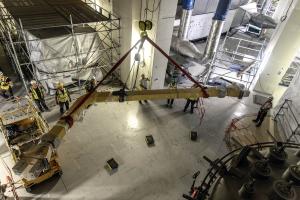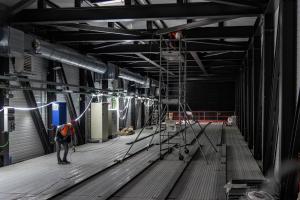Navigating an obstacle course
What is simple and commonplace in the ordinary world, like connecting an electrical device to a power source, often takes on extraordinary dimension at ITER. Whereas in most daily-life circumstances, copper cables ranging in diameter from a few millimetres to the thickness of an arm are sufficient to transport electrical current at the appropriate intensity, some components in ITER are so unique that they require a highly sophisticated, oversized electricity distribution system.
Originating in the twin Magnet Power Conversion buildings and spanning the worksite's "central boulevard" by way of two 50-metre-long bridges, a dense network (5 km) of steel-jacketed, actively cooled aluminum bars protected by canary-yellow casing snakes into the Tokamak Complex to deliver high-intensity DC current to the machine's magnets. The thickest of these "busbars," thicker than a train rail, are dimensioned to carry up to 70 kiloamperes (kA)—7,000 times more than a heavy-duty electrical cable.
Busbar installation began in 2019 and is now 55 percent complete. As space in the galleries inside the Tokamak Complex is getting more constrained by the day, busbar transport and positioning procedures now require 3D modelling and simulations.
On Wednesday 4 September, the teams installed a 1.5-tonne boomerang-shaped busbar destined for the central solenoid feeder system. From the beginning, the operation presented some unique challenges. "Due to the number of obstacles between the cargo lift (the system that delivers loads to the different levels of the building) and the destination, we had to find an alternate path to deliver the component," explains Arantxa Iniesta-Mancillas, Construction Manager for the DC busbars and most systems feeding power to the reactor.
The busbar (4.8 m x 5.3 m) was moved through the Cleaning Facility to the Assembly Hall by means of rolling carts, then lifted by overhead crane over the wall and deposited in a wide delivery area in the Tokamak Building. The final leg of the transfer was smooth but no less delicate as the busbar had to pass over three massive auxiliary cold boxes with limited overhead clearance.
This last phase was made possible by the availability of a smaller overhead crane, recently installed for maintenance operations to the cryogenic system. "Without the overhead crane, we would have had to dismantle all the scaffolding around the area in order to clear a path for the busbar, which would have had a major impact on other work fronts and contractors." Two other similar, boomerang-shaped busbars need to be installed in the same area and connected to the busbar lines crossing the Diagnostics Building.
Approximately 70% of the busbar lengths expected from ITER Russia (402 out of 570) have been received on site.




